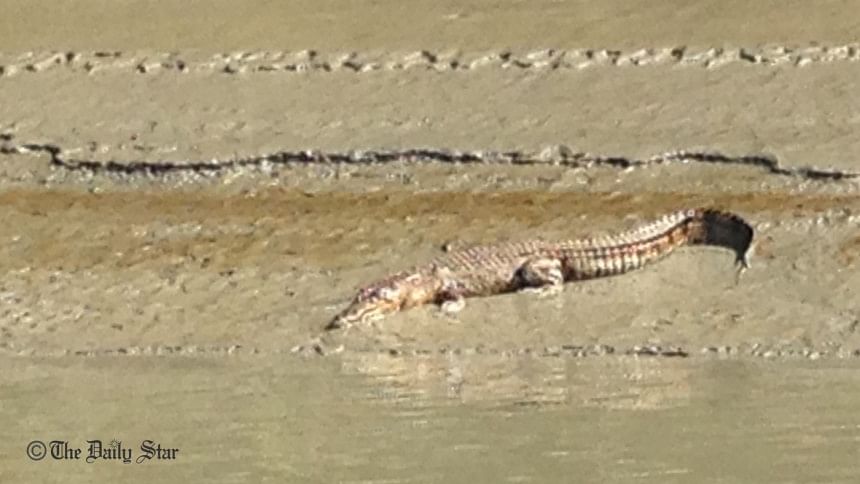Crocodiles also facing trouble in Sundarbans

The crocodile population in the Sundarbans has declined further due to rapid destruction of their breeding grounds and unchecked poaching, according to the preliminary findings of a new crocodile survey carried out in the mangrove forest.
The survey predicts that there are now only 120-130 crocodiles in the rivers and canals of the forest while the number was about 200 in 2004.
Bangladesh Forest Department and Centre for Advanced Research in Natural Resources & Management (CARINAM), a wildlife research organisation, jointly conducted the survey to ascertain crocodile population in the Sundarbans.
The Tk 1.24-crore Crocodile Survey Project was taken with financial support from the World Bank.
An eighty-member team, comprising experts and trained forest officials, divided into four groups, collected field-level data from four ranges of the whole forest during January 31 to February 15, 2016.
The Global Positioning System (GPS) was used for the first time during the survey to identify the locations of crocodiles live in there.
The GPS is a space-based navigation system that provides location and time information in all weather conditions.
Forest officials said the Forest Department is now examining the data collected from the field level, and it is expected that the actual number of the Sundarbans' crocodiles would be announced in May next.
Divisional forest officer (Khulan) and survey coordinator M Jahidul Kabir said it is not possible to say the exact figure of crocodiles without examining the field-level data.
"But we, based on field-level data, can primarily predict that there would be about 100 crocodiles in the Sundarbans."
The Sundarbans, a natural habitat to wildlife, including the tiger, crocodile and dolphin, is located in three coastal districts - Khulna, Bagerhat and Satkhira - covering a range of 6,017 square kilometers.
There are around 450 canals and rivers inside the mangrove forest, which are the habitat to crocodiles.
Wildlife experts, who took part in the survey, observed that there is a huge possibility of enhancing crocodile population to several thousands in the Sundarbans, but its number has declined to nearly 100 due to destruction of their habitat.
CARINAM chief executive and principal investigator of the crocodile survey Dr SMA Rashid said there should be several thousands of crocodile in canals and rivers of the Sundarbans, but crocodile population has declined here in recent years.
Rapid destruction of crocodiles' breeding grounds, unchecked poaching and fishermen's indiscriminate access to rivers and canals of the Sundarbans contribute to the rapid fall in the crocodile population of the forest, he said.
Divisional forest officer (Sundarbans East) M Saidul Islam said the Forest Department established a crocodile breeding centre at Karamjal point of the Sundarbans to save the endangered salt-water crocodiles.
"About 19 salt-water crocodiles have already been released to the canals and rivers of the Sundarbans from the breeding centre...now there are also 264 crocodiles in the centre," he added.
Wildlife is currently facing various troubles in the country due to unchecked poaching and destruction of natural forests. According to the Tiger Census 2015, tiger population also declined to only 106 tigers in the Bangladesh part of the Sundarbans in 2015 while it was 440 in 2004.

 For all latest news, follow The Daily Star's Google News channel.
For all latest news, follow The Daily Star's Google News channel. 







Comments